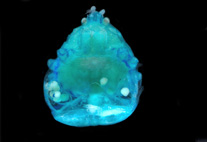Abstract
Six species of Prionospio are described from the Southern Gulf of Mexico and the Caribbean Sea. Five of these species, P. austella sp. nov., P. crassumbranchiata sp. nov., P. jonatani sp. nov., P. oligopinnulata sp. nov., and P. rotunda sp. nov. are new to science whereas Prionospio cristata Foster, 1971 has been previously described from the Grand Caribbean region. P. austella sp. nov. has a prostomium with a small medial peak on the anterior margin, low dorsal folds on chaetigers 6–11, rounded and subtriangular neuropodial lamellae on chaetigers 1 and 3, respectively, and all hooks lack a secondary hood. P. crassumbranchiata sp. nov. has a laterally separate peristomium partially fused dorsally with chaetiger 1, digitiform pinnules on the lateral and posterior faces of the first pair of branchiae and rectangular neuropodial lamellae on chaetigers 2–5. Prionospio jonatani sp. nov. has a narrow prostomium, subtriangular notopodial lamellae on chaetigers 6–21, notopodial prechaetal lamellae slightly basally fused with the notopodial postchaetal lamellae and square neuropodial lamellae on chaetiger 3. P. oligopinnulata sp. nov. has a square-shaped prostomium, high dorsal crests on chaetigers 7–8, low dorsal folds on chaetigers 9–14, subtriangular neuropodial lamellae on chaetigers 2–3, and branchial pairs 2 and 3 are triangular. P. rotunda sp. nov. has an anteriorly rounded prostomium, trapezoid neuropodial lamellae on chaetiger 3, high dorsal crests on chaetiger 7, and branchial pairs 2 and 3 are cirriform. A key is provided for all the species known from the Grand Caribbean region in the “steentrupi-group” with four branchial pairs.

